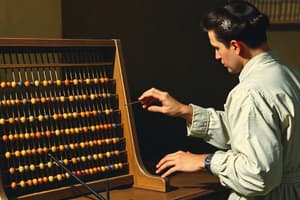Podcast
Questions and Answers
What was the first electronic digital programmable computer?
What was the first electronic digital programmable computer?
- The Z3
- Colossus
- The Atanasoff-Berry Computer (ABC
- ENIAC (correct)
Who proposed the principle of the modern computer in his 1936 paper?
Who proposed the principle of the modern computer in his 1936 paper?
- Charles Babbage
- Lord Kelvin
- Alan Turing (correct)
- Konrad Zuse
What is the function of the arithmetic logic unit (ALU) in a general-purpose computer?
What is the function of the arithmetic logic unit (ALU) in a general-purpose computer?
- To perform arithmetic and logic operations (correct)
- To read and interpret program instructions
- To transform program instructions into control signals
- To manage the computer's various components
What was the first stored-program computer?
What was the first stored-program computer?
What is the purpose of peripheral devices in a computer system?
What is the purpose of peripheral devices in a computer system?
What is the difference between a microprocessor and a microcomputer?
What is the difference between a microprocessor and a microcomputer?
What is the purpose of a compiler in programming?
What is the purpose of a compiler in programming?
What is the significance of MOS IC technology in computer design?
What is the significance of MOS IC technology in computer design?
What is the purpose of a control unit in a general-purpose computer?
What is the purpose of a control unit in a general-purpose computer?
What is the difference between a computer and a human computer?
What is the difference between a computer and a human computer?
Flashcards are hidden until you start studying
Study Notes
- A computer is a machine that can be programmed to carry out arithmetic or logical operations automatically.
- Computers can perform a wide range of tasks through programs.
- Computers can be used as control systems in industrial and consumer products.
- Early computers were used only for calculations, and mechanical devices were built to automate long, tedious tasks.
- The first digital electronic calculating machines were developed during World War II, leading to the microprocessor and the microcomputer revolution in the 1970s.
- A modern computer consists of at least one processing element, typically a central processing unit (CPU) in the form of a microprocessor, along with some type of computer memory.
- Peripheral devices include input devices, output devices, and input/output devices.
- The word "computer" originally referred to a human computer, a person who carried out calculations or computations.
- Devices have been used to aid computation for thousands of years, including the abacus and the slide rule.
- Mechanical aids to calculation and measurement were constructed for astronomical and navigation use.
- Charles Babbage invented the first mechanical computer in the early 19th century.
- The first modern analog computer was a tide-predicting machine invented by Lord Kelvin in 1872.
- The first electromechanical analog computer was developed by the US Navy in 1938.
- The Z3, built by Konrad Zuse in 1941, was the world's first working electromechanical programmable digital computer.
- The Z4, built by Zuse in 1950, was the world's first commercial computer.
- The Atanasoff-Berry Computer (ABC) was the first automatic electronic digital computer, developed in the US in 1942.
- Colossus, built in 1943, was the world's first electronic digital programmable computer.
- ENIAC, built in the US in 1945, was the first electronic programmable computer.
- The principle of the modern computer was proposed by Alan Turing in his 1936 paper, On Computable Numbers.
- Modern computers are based on the concept of a universal Turing machine.
- Turing proposed the stored-program computer in 1936, allowing instructions to be stored in memory.
- The Manchester Baby was the first stored-program computer, followed by the Ferranti Mark 1.
- Grace Hopper developed the first compiler for a programming language.
- Transistors replaced vacuum tubes in computer designs in the 1950s.
- The MOSFET transistor was invented in 1959, leading to the microcomputer revolution.
- The integrated circuit (IC) was invented by Kilby and Noyce in the late 1950s.
- MOS ICs led to the invention of the microprocessor, starting with the Intel 4004.
- MOS IC technology enabled the integration of over 10,000 transistors on a single chip.
- System on a Chip (SoCs) are complete computers on a microchip.
- SoCs may or may not have integrated RAM and flash memory.
- Computers have advanced greatly since the first one in 1945, with modern SoCs being the size of a coin and hundreds of thousands of times more powerful than ENIAC.
- The first mobile computers were heavy and ran from mains power, but laptops removed this requirement by incorporating batteries.
- Portable computers grew in popularity in the 2000s, and smartphones and tablets became the dominant computing device on the market.
- Computers can be classified by architecture, size, form-factor, and purpose.
- Hardware covers all the tangible physical parts of a computer, including circuits, computer chips, graphic cards, sound cards, memory, motherboard, displays, power supplies, cables, keyboards, printers, and input devices.
- A general-purpose computer has four main components: the arithmetic logic unit (ALU), the control unit, the memory, and the input and output devices (I/O).
- Input devices include hand-operated or automated devices that send unprocessed data to the computer.
- Output devices include the means through which the computer gives output.
- The control unit manages the computer's various components, reads and interprets program instructions, and transforms them into control signals that activate other parts of the computer.
- The ALU is capable of performing arithmetic and logic operations, and the memory can be viewed as a list of cells into which numbers can be placed or read.
Studying That Suits You
Use AI to generate personalized quizzes and flashcards to suit your learning preferences.




